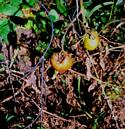If there’s one thing we gardeners in the Pacific Northwest know about, it’s how to grow tomatoes in the most difficult conditions. It’s bad enough that our summers are normally very cool but now the coming weeks are filled with hot days and warm nights, the perfect breeding ground for late blight disease.
Phytophthora infestans, the fungus that causes this disease, is the same one responsible for the Irish Potato famine. Within the last 10 years, late blight disease has made a come back in North America and Europe. Strains have developed that are resistant to fungicide applications and international trade has helped transmit infected plant material across borders.
The disease infects both potatoes and tomatoes. Overwintering potato tubers can harbor the disease that soon spreads as soon as the tubers sprout. Spores, produced by the fungus can travel in the wind for up to 20 kilometers. This means that even if you’ve never had late blight in your garden before, it can be blown in from neighbors who do.
As temperatures rise above 15°C, the chance of infection increases. The spores themselves require just a thin layer of moisture on the surface of the plant in order to infect it. Within 2 days of the initial infection, the host cells begin to die. The telltale signs of the disease – blackening of the stems & leaves and oily-looking splotches on the fruit – then begin to appear.
Very little can be done to prevent spores from landing on your plants; protecting plants against the rain is the best defense. Since the spores of late blight require moisture before they can infect tomato and potato plants, a clear plastic cover over the plants is a simple method of preventing this devastating disease. Alternatively, try growing tomato plants in containers up against the house so that the eaves protect them.
Some cultural practices that can help prevent infection:
- Gardeners should be careful not to wet any of the leaves when watering, especially from late June to late August when the disease is prevalent.
- Secondly, try to encourage as much air movement around the plants as possible by spacing tomato plants at least 2 feet away from each other. Try not to allow foliage to overlap.
- Indeterminate tomatoes, the kind that requires staking, need to be pruned of their suckers so that plants are not overly bushy and dense.
- Copper sulphate, also known as Bordeaux spray, will help keep this disease in check if the plants cannot be covered. However, this spraying regime should be started before you see signs of the disease. Make sure to read to directions carefully and do not eat the fruit for at least one day after spraying.
- Do not plant tomatoes where potatoes were grown the previous year.
- Make sure you harvest all your potato tubers and dispose of any plant material left after the growing season.
Once late blight hits your tomatoes, it really is too late. Infected plants become sources of spores that can spread to other gardens and farms. They should really be removed and placed in the garbage, not the compost pile. In potatoes, as soon as signs of the disease appear, cut down the foliage and dispose of it. Wait approximately 2 weeks before you harvest your tubers – enough time to allow any of the spores on the surface of the soil to die.
Resources
Late Blight Disease on Home Garden Tomatoes
http://www.agf.gov.bc.ca/croplive/cropprot/lateblighthg.htm
Late Blight in Potatoes
http://plantclinic.cornell.edu/vegetable/lateblight/late.htm

